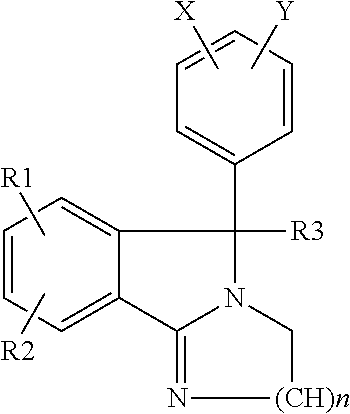Use of isoindoles for the treatment of neurobehavioral disorders
a neurobehavioral and isoindole technology, applied in the direction of nervous disorders, medical preparations, drug compositions, etc., can solve the problem of insufficient glutamate transport and receptor activation
- Summary
- Abstract
- Description
- Claims
- Application Information
AI Technical Summary
Problems solved by technology
Method used
Image
Examples
example 1
[0124]To determine if all three monoamine transporters of the TMMS were involved with the pathophysiology of various neurobehavioral disorders, polymorphic variants within genes regulating synthesis, metabolism, and receptor binding of DA, 5HT and NE were examined. Genomic deoxyribonucleic acid (DNA) was obtained from patient's with various neurobehavioral disorders selected from the categories of: 1) pervasive developmental disorders and / or autism spectrum disorders (PNDS), 2) impulse control disorders and / or reward deficiency disorders (RDDS), 3) obsessive-compulsive spectrum disorders (OCDS), 4) dementia disorders (DEMS), 5) somatoform disorders (SOMS) and 6) movement disorders (MOVS). To examine the pharmacologic targets of the compounds that are the subject of this patent application, polymorphic variants present in the genomic DNA of patients afflicted with the disorders were compared to those in the DNA of non-affected control individuals. The Solute Carrier (SLC) genes; SLC6...
example 2
[0126]Several compounds according to Formula 1 were tested in vitro for their ability to simultaneously and differentially inhibit binding of radioligands to dopamine (DA), norepinephrine (NE) and serotonin (5HT) transporters in the desired Ki ratio. These transporters control the amount of the three monoamines in the TMMS and therefore regulate fast excitatory and inhibitory neurotransmission in the CNS. Thus, the relative amounts of all three of these monoamines in the TMMS of brain controls mammalian neurobehaviors. To determine the Ki of the representative compounds; recombinant human monoamine transporters (DAT, SERT and NET) were expressed in HEK-293 cells as described in Eshleman et al. (1999). The HEK-hDAT, HEK-hSERT and HEK-hNET cells were incubated in modified Eagle's medium or Dulbecco's modified Eagle's medium exactly as described by Eshleman et al. Cells were grown until confluent on 150 mm diameter tissue culture dishes in a humidified 10% CO2 environment at 37° C. The...
example 3
[0128]P. M. is a 14 year old male. At 4 years of age a diagnosis of ADHD was made and he was treated with Ritalin (methylphenidate) with some improvement in attention span but little effect on several other neurobehavioral symptoms, including abusive behavior and depression. At age 9 years of age, he was also being treated with risperidone which continued for 2 years. At 13 years of age the patient was started on Mazindol at 2.5 mg BID and the Ritalin was discontinued. Within 2 months he reported improved attention span, loss of hyperactivity and his bad behavior as a result of his impulsivity significantly improved. Subsequently, the risperidone was then completely discontinued without any recurrence of symptoms of ADHD (i.e. poor attention span, hyperactivity, or inappropriate behavior). The patient was then maintained on Mazindol at 2.5 mg / day as the sole agent without the return of any symptoms of ADHD over the next 3 years.
PUM
| Property | Measurement | Unit |
|---|---|---|
| diameter | aaaaa | aaaaa |
| volume | aaaaa | aaaaa |
| time | aaaaa | aaaaa |
Abstract
Description
Claims
Application Information
 Login to View More
Login to View More - R&D
- Intellectual Property
- Life Sciences
- Materials
- Tech Scout
- Unparalleled Data Quality
- Higher Quality Content
- 60% Fewer Hallucinations
Browse by: Latest US Patents, China's latest patents, Technical Efficacy Thesaurus, Application Domain, Technology Topic, Popular Technical Reports.
© 2025 PatSnap. All rights reserved.Legal|Privacy policy|Modern Slavery Act Transparency Statement|Sitemap|About US| Contact US: help@patsnap.com

